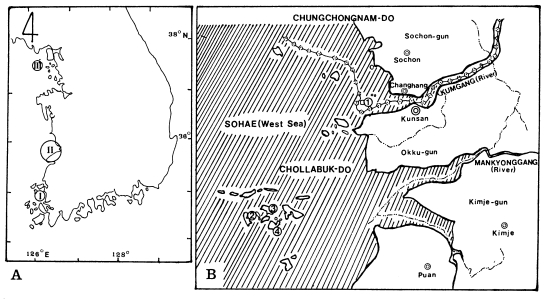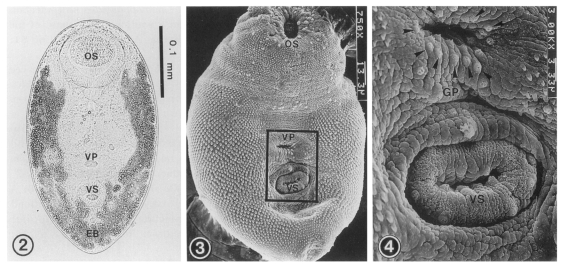Discovery of Gymnophalloides seoi metacercariae in oysters from islands of the West Sea known as the habitats of paleartic oystercatchers
Article information
Abstract
An epidemiological survey was performed to know the infection status of oysters with Gymnophalloides seoi metacercariae in 7 islands of the West Sea known as the habitat of paleartic oystercatchers, Haematopus ostralegus osculans, in Korea. The surveyed areas were Aphaedo (Shinan-gun, Chollanam-do), Jangjado, Sonyudo and Munyodo (Okdo-myon, Kunsan-shi, Chollabuk-do), Yubudo (Changhang-up, Sochon-gun Chungchongnam-do), and Polumdo and Chumoondo (Sodo-myon, Kangwha-gun. Inchon-shi). The oysters collected from Aphaedo, the known endemic focus, were examined monthly from August 1995 to October 1996 for observation of any seasonal variation of the metacercarial density. The average metacercarial burden was 761-2,077 by month, but the seasonal variation of the metacercarial density was not obvious. A total of 54 metacercariae was detected in 63 oysters collected from Yubudo. Out of 30 oysters from Sonyudo, 25 (83.3%) were infected with 1-66 metacercariae (12.6 in average). All of 50 oysters (100%) from Munyodo were infected with 3-162 metacercariae (53.5 in average). Only 4 metacercariae were detected in 100 oysters from Chumoondo. However, no metacercariae were found in 55 oysters from Jangjado and 50 oysters from Polumdo. From the above results, it was confirmed that G. seoi is still highly prevalent in oysters from Aphaedo, and several islands of the West Sea known as the habitats of paleartic oystercatchers are new endemic areas of this fluke.
INTRODUCTION
Gymnophalloides seoi (Digenea: Gymnophallidae) is a new human intestinal trematode recently reported in Korea (Lee et at, 1993). Aphaedo (Island), Shinan-gun, Chollanam-do, has been known as a highly endemic area of G. seoi with a high infection rate of the people (Lee et at, 1994), and this fluke is contracted by eating raw oysters, Crassostrea gigas (Lee et al., 1995b). A nationwide survey of naturally produced oysters revealed that G. seoi is mainly distributed around the boundary of Shinan-gun. the known endemic area (Lee et al., 1996). The first intermediate host of this fluke has not been known yet.
Recently the paleartic oystercatcher, Haematopus ostralegus osculans, was reported as a natural final host of G. seoi (Ryang et al., 1996). It is well known that this migratory bird inhabits along the tidal flat of the West Sea; especially in the coast of some adjacent islands of Mokpo-shi, Kunsan-shi and Kangwha-gun (Won, 1993). In this connection, we performed an epidemiological survey to know the infection status of oysters with G. seoi metacercariae on several islands of the West Sea.
MATERIALS AND METHODS
The surveyed areas were mainly divided into 3 regions by the geographical location (Fig. 1). The area I was Aphaedo (Island), the known highly endemic area, of Shinan-gun, Chollanam-do. The area II consisted of 4 islands, i.e. Jangjado, Sonyudo, and Munyodo (Okdo-myon, Kunsan-shi, Chollabuk-do), and Yubudo (Changhang-up, Sochon-gun Chungchongnam-do). The area III included 2 islands; Polumdo and Chumoondo (Sodo-myon, Kangwha-gun, Inchon-shi).

Map of the surveyed areas. A. Three surveyed areas (I, Aphae-myon, Shinan-gun, Chollanam-do; II, Okdo-myon, Kunsan-shi, Chollabuk-do and Changhang-up, sochon-gun Chunchongbuk-do; III, Sodo-myon, Kangwha-gun, Inchon-shi). B. The detail map of the surveyed area II (① Yobudo (Island); ② Jangjado; ③ Sonyundo; ④ Munyodo).
The oysters collected were transported to our laboratory and their shells were removed after weighing. Each animal part of the oysters was digested with pepsin-HCl solution for 15 min in a 36℃ incubator. The digested material was washed with 0.85% saline until the supernatant became clear. The metacercariae were collected from the sediment of the digested material under a stereomicroscope. Especially in Aphaedo, 20 oysters were examined in each month from August 1995 through October 1996 and the monthly infection status with G. seoi metacercariae were examined. Oysters from Yubudo and Jangjado were not possible to examine individually because they were too small in size and firmly attached each other. Therefore, they were totally digested and examined.
For identification of the species, metacercariae collected from the area II and III were fixed with 10% neutral buffered formalin under a cover glass pressure. Others were orally infected to mice for recovery of adult worms. Metacercariae and adult flukes recovered from the mice were stained with Semichon's acetocarmine, observed under a light microscope and measured. Several metacercariae were fixed with 2.5% glutaraldehyde for SEM study, and were observed with a DS-130C SEM.
RESULTS
Monthly infection status of oysters with G. seoi metacercariae from Aphaedo
A total of 248 (88.6%) out of 280 oysters collected from Aphaedo were found to harbor 1 to 5,012 G. seoi metacercariae (1,339 in average) (Table 1). The lowest infection rate, 25%, was observed in January 1996. However, the average number of metacercariae per oyster was lowest in August 1995, and highest in October 1996.
Metacercarial density by weight of oysters
The average numbers of metacercariae per oyster were 936 in the group of weight below 20 g, 1,175 in 21-30 g, 1,591 in 31-40 g group, and 1,856 in the group of over 41 g (Table 2). The metacercarial densities were slightly increased by the weight of oysters.
Infection status of oysters from the area II and III with G. seoi metacercariae
A total of 54 metacercariae was detected from 63 oysters collected from Yubodo. Out of 30 oysters from Sonyudo, 25 (83,3%) were infected with 1-66 metacercariae (12.6 in average). All of 50 oysters (100%)) from Munyodo were infected with 3-162 metacercariae (53.5 in average). However, no metacercariae were detected in the oysters from Jangjado (Table 3).
Only 4 metacercariae were detected from 100 oysters in Chumoondo. However, no metacercariae were detected from 50 oysters in Polumdo.
Morphology of the metacercariae from oysters of the area II and adults recovered from experimental mice
Metacercariae were small and pyriform, and 0.250-0.365 mm (0.303 in average) × 0.1550-0.195 mm (0.177) in size. Oral sucker (0.086 × 0.095 mm) with a pair of ventrolateral lips was larger than the ventral, and followed by a muscular pharyx (0.023 × 0.027 mm), a short esophagus and inflated ceca. Ventral pit was conspicuous and located in posterior 2/5 of body. Ventral sucker (0.037 × 0.038 mm) was located in posterior 1 /3 of body. Genital pore was small and inconspicuous, and opened at anterior margin of the ventral sucker. Excretory bladder was V shaped, extended to the oral sucker level, and filled with many tiny granules (Fig. 2). In the metacercaria observed with a SEM, tegumental spines were distributed on the whole body surface except the median portion between the anterior 1/3 level of body and the just posterior of ventral sucker, and many ciliated sensory papillae were distributed around the ventral pit (Figs. 3 & 4). The morphology of adults was very similar with that of metacercariae. Eggs in uterus were embryonated and elliptical with thin shell, and 0.021 × 0.014 mm in average size.

A metacercaria of Gymnophalloides seoi found in an oyster from Munyodo (Island), in Okdo-myon, Kunsan-shi, showing the oral sucker (OS), ventral pit (VP), ventral sucker (VS), and excretory bladder (EB). Fig. 3. SEM view of G. seoi metacercaria. Fig. 4. Magnified of the boxed area in Fig. 3, showing sensory papillae (arrow heads) around the ventral pit, and genital pore (GP).
DISCUSSION
Various kinds of marine bivalves were reported as the second intermediate host of gymnophallid flukes in Korea and other countries (Loss-Frank, 1971; Yu et al., 1993). In Korea, the short-necked clams, Tapes philippinarum, were found infected with the metacercariae of Paruatrema timondavidi (Yu et al. 1993). Another kind of Parvatrema sp. metacercariae was found from Mactra veneriformis, one of the surf clams (unpublished data). The metacercariae of G. seoi, the only known human-infecting gymnophallid, were found from oysters, Crassostrea gigas (Lee et al., 1995b).
The paleartic oystercatcher, Haematopus ostralegus osculans, has been reported as a natural final host of G. seoi (Ryang et al. 1996). This migratory bird mainly inhabits along the tidal flat of the West Sea, especially coastal areas of Hwanghae-do and Kangwha-gun, the mouth of Kumgang (River), islands of Okdo-myon (Kunsan-shi), and coastal areas and islands nearby Mokpo-shi (Won, 1993), There is a strong possibility that G. seoi might be distributed along the habitats of the oystercatcher since the distribution of trematodes is closely related to the presence of their hosts.
In the present study, it has been proven that G. seoi is distributed in several islands of the West Sea which are known as the habitats of paleartic oystercatchers. The surveyed area II consisting of 4 islands, i.e. Yubudo, Jangjado, Sonyudo and Munyodo, is situated nearby Puan-gun where G. seoi metacercariae were already found in an oyster (Lee et al., 1996). The infection rate and density of metacercariae in this area were, however, lower than the endemic area in Shinan-gun, Chollanam-do. However, the infection status in this area was similar with those of other parts of Shinan-gun except two highly endemic areas, Aphae-myon and Chungdo-myon (Lee et at., 1996). The surveyed area III was one of the suspected endemic areas, since one patient living in Inchon consumed raw oysters collected from Kangwha-gun and found infected with this fluke (Lee et at., 1995a). By the present study, this area has been proven to be an endemic area with infected oysters, although the infection rate and density of metacercariae were very low.
Seasonal variation of the metacercarial density was reported in a few species of gymnophallid flukes. Pekkarinen (1983) reported that the number of Lacunovermis macomae metacercariae in Macoma balthica slightly increased in summer season. Erasmus (1972) also mentioned that the incidence of metacercariae will generally rise in summer. In the present study, however, no significant seasonal variation was recognized in the metacercarial density of G. seoi. Moreover, the metacercarial density in August of 1995 and 1996 were both lower than that in other months. It is at present obscure whether this finding is consistent or not.
The total infection rate of oysters with G. seoi metacercariae in Aphaedo was lower in this study than that of Lee et al. (1995b). However, the average infection density was higher in this study than those of Lee et al. (1995b & 1996), Accordingly, it is strongly suggested that G. seoi is still highly prevalent in the known endemic focus of Shinan-gun, Chollanam-do.
In the present study, the relationship between the weight of oysters and intensity of metacercarial infection was observed in oysters collected from the same place of the endemic area in Shinan-gun. The average metacercarial density was positively increased by the weight of oysters. Such a positive correlation was also observed in M. balthica infected with Parvatrema affinis (Hulscher, 1973) and L. macomae (Pekkarinen, 1984).
The metacercariae of G. seoi found in oysters from the new endemic areas were a little smaller in size than those reported by Lee et al. (1995b). The adult worms recovered from experimental mice were also smaller in this study than those of Lee et al. (1995b) and those from the first human case (Lee et at, 1993). However, other morphological characteristics were identical with the original descriptions of G. seoi (Lee et al., 1993 & 1995b).
Based on the results of the present study, it could be concluded that the distribution of G. seoi is closely related with the distribution of the natural final host, the paleartic oystercatcher, and several islands of the West Sea have been proven to be endemic areas of this fluke. It was confirmed that G. seoi is still highly prevalent in Aphaedo, the known endemic area.
Notes
This Study was supported by the Basic Medical Research Fund, the Ministry of Education, Republic of Korea, 1995-1996.


